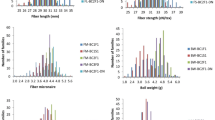Abstract
A backcross-self population from a cross between Gossypium hirsutum and G. barbadense was used to dissect the molecular basis of genetic variation governing two parameters reflecting lint fiber fineness and to compare the precision of these two measurements. By applying a detailed restriction fragment length polymorphism (RFLP) map to 3,662 BC3F2 plants from 24 independently derived BC3 families, we were able to detect 32 and nine quantitative trait loci (QTLs) for fiber fineness and micronaire (MIC), respectively. The discovery of larger numbers of QTLs in this study than previously found in other studies based on F2 populations grown in favorable environments reflects the ability of the backcross-self design to resolve smaller QTL effects. Although the two measurements differed dramatically in the number of QTLs detected, seven of the nine MIC QTLs were also associated with fiber fineness. This supports other data in suggesting that fiber fineness more accurately reflects the underlying physical properties of cotton fibers and, consequently, is a preferable trait for selection. “Negative transgression,” with the majority of BC3F2 families showing average phenotypes that were poorer than that of the inferior parent, suggests that many of the new gene combinations formed by interspecific hybridization are maladaptive and may contribute to the lack of progress in utilizing G. barbadense in conventional breeding programs to improve upland cotton.


Similar content being viewed by others
References
Bradow JM, Davidonis GH (2000) Quantitation of fiber quality and the cotton production-processing interface: A physiologist’s perspective. J Cotton Sci 4:34–64
Chee P, Draye X, Jiang C, Decanini L, Delmonte T, Bredhauer B, Smith CW, Paterson AH (2005) Molecular dissection of interspecific variation between Gossypium hirsutum and G. barbadense (cotton) by a backcross-self approach: I. Fiber elongation. Theor Appl Genet (in press) doi:10.1007/s00122-005-2063-z
Hequet E, Wyatt B (2001) Relationship among image analysis on cotton fiber cross sections, AFIS measurements and yarn quality. Proc Beltwide Cotton Conf 2:1294–1298
Jiang C, Wright R, El-Zik K, Paterson A (1998) Polyploid formation created unique avenues for response to selection in Gossypium (Cotton). Proc Natl Acad Sci USA 95:4419–4424
Jiang C, Chee P, Draye X, Morrell P, Smith C, Paterson A (2000) Multi-locus interactions restrict gene flow in advanced-generation interspecific populations of polyploid Gossypium (Cotton). Evolution 54:798–814
Kohel RJ, Yu J, Parkj YH, Lazo G (2001) Molecular mapping and characterization of traits controlling fiber quality in cotton. Euphytica 121:162–172
May OL (2000) Genetic variation for fiber quality. In: Basra AS (ed) Cotton fibers—developmental biology, quality improvement, and textile processing. Food Products Press, New York, pp 183–229
Mei M, Syed NH, Gao W, Thaxton PM, Smith CW, Stell DM, Chen ZJ (2004) Genetic mapping and QTL analysis of fiber-related traits in cotton (Gossypium). Theor Appl Genet 108:280–291
Meredith WR (1994) Genetics and management factors influencing textile fiber quality. In: Chewing C (ed) Proc 7th Ann Cotton Incorporated Engineered Fiber Selection System Res Forum. Cotton Incorporated, Raleigh, N.C., pp 256–261
Meredith WR, Sasser PE, Rayburn ST (1996) Regional high quality fiber properties as measured by conventional and ADIS methods. In: Dugger P, Rrichter DA (eds) Proc Beltwide Cotton Production Res Conf. National Cotton Council, Memphis, Tenn., pp 1861–1684
Monforte AJ, Tanksley SD (2000) Development of a set of near isogenic and backcross recombinant inbred lines containing most of the Lycopersicon hirsutum genome in a L. esculentum genetic background: A tool for gene mapping and gene discovery. Theor Appl Genet 43:803–813
Paterson AH, Saranga Y, Menz M, Jiang C, Wright RJ (2003) QTL analysis of genotype×environmental interactions affecting cotton fiber quality. Theor Appl Genet 106:384–396
Reinisch AJ, Dong JM, Brubaker C, Stelly D, Wendel JF, Paterson AP (1994) A detailed RFLP map of cotton (Gossypium hirsutum× Gossypium barbadense): chromosome organization and evolution in a disomic polyploid genome. Genetics 138:829–847
Rong J, Abbey C, Bowers JE, Brubaker CL, Chang C, Chee PW, Delmonte TA et al. (2004) A 3347-locus genetic recombination map of sequence-tagged sites reveals features of genome organization, transmission and evolution of cotton (Gossypium). Genetics 166:389–417
SAS Institute (1999) SAS/STAT user’s guide, version 8. SAS Institute, Cary, N.C.
Self SG, Liang KL (1987) Asymptotic properties of maximum likelihood estimators and likelihood ratio tests under nonstandard conditions. J Am Stat Assoc 82:605–610
Steadman RG (1997) Cotton testing. In: Smirfitt JA (ed) Textile progress. The Textile Institute, Manchester, pp 24–28
Young ND, Tanksley SD (1989) RFLP analysis of the size of chromosomal segments retained around the Tm-2 locus of tomato during backcross breeding. Theor Appl Genet 77:353–359
Acknowledgements
We acknowledge the financial support from the Texas and Georgia Agricultural Experiment Stations, Texas Higher Education Coordinating Board, Cotton Incorporated, and USDA-IFAFS. XD was a postdoctoral research associate of the Fonds National Belge de la Recherche Scientifique.
Conflict of interest:
No information supplied
Author information
Authors and Affiliations
Corresponding author
Additional information
Communicated by F. Salamini
Electronic Supplementary Material
Rights and permissions
About this article
Cite this article
Draye, X., Chee, P., Jiang, CX. et al. Molecular dissection of interspecific variation between Gossypium hirsutum and G. barbadense (cotton) by a backcross-self approach: II. Fiber fineness. Theor Appl Genet 111, 764–771 (2005). https://doi.org/10.1007/s00122-005-2061-1
Received:
Accepted:
Published:
Issue Date:
DOI: https://doi.org/10.1007/s00122-005-2061-1




